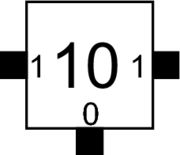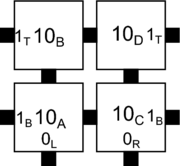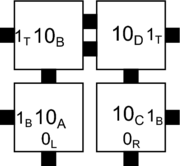Difference between revisions of "Snaked Proofreading"
(Created page with "In <ref name=ChenGoel04 />, Chen and Goel demonstrated a tile set transformation which provided improvements over the previous proofreading technique. In fact, their ''snaked pr...") |
|||
| Line 1: | Line 1: | ||
| − | In <ref name=ChenGoel04 />, Chen and Goel demonstrated a tile set transformation which provided improvements over the previous proofreading technique. In fact, their ''snaked proofreading'' technique not only provides substantial improvements in error correction, it also provides for "provably good" assembly time, or specifically that it allows for close to linear assembly time (within a logarithmic factor of irreversible error-free growth). Snaked proofreading relies on a block replacement scheme similar to the proofreading of Winfree and Bekbolatov <ref name=WinBek03 />, but with a different internal bond structure. An example of the difference can be seen in Figure | + | In <ref name=ChenGoel04 />, Chen and Goel demonstrated a tile set transformation which provided improvements over the previous proofreading technique. In fact, their ''snaked proofreading'' technique not only provides substantial improvements in error correction, it also provides for "provably good" assembly time, or specifically that it allows for close to linear assembly time (within a logarithmic factor of irreversible error-free growth). Snaked proofreading relies on a block replacement scheme similar to the proofreading of Winfree and Bekbolatov <ref name=WinBek03 />, but with a different internal bond structure. An example of the difference can be seen in Figure 1 (below). The general technique is to force multiple insufficient attachments to occur and be locked into place before an error can persist. |
Especially notable is the fact that snaked proofreading does not only provide benefits in simulations of the kTAM, but in <ref name=CheSchGoeWin07 /> Chen, Schulman, Goel, and Winfree actually created a tile set which utilized the technique and experimented with it in a wet-lab setting. They created tile sets which self-assembled into long ribbons, some which were designed to implement snaked proofreading and some which were not, and were able to verify via atomic force microscopy that the snaked proofreading tile sets experienced a $4$-fold reduction in facet nucleation errors. | Especially notable is the fact that snaked proofreading does not only provide benefits in simulations of the kTAM, but in <ref name=CheSchGoeWin07 /> Chen, Schulman, Goel, and Winfree actually created a tile set which utilized the technique and experimented with it in a wet-lab setting. They created tile sets which self-assembled into long ribbons, some which were designed to implement snaked proofreading and some which were not, and were able to verify via atomic force microscopy that the snaked proofreading tile sets experienced a $4$-fold reduction in facet nucleation errors. | ||
{{multiple image | {{multiple image | ||
| − | | align = | + | | align = center |
| width = 180 | | width = 180 | ||
| − | | footer = A comparison of the block replacement transformations used in standard proofreading and snaked proofreading | + | | footer = Figure 1. A comparison of the block replacement transformations used in standard proofreading and snaked proofreading |
| image1 = snaked-example-original.png | | image1 = snaked-example-original.png | ||
| alt1 = Sierpinski Growth Error | | alt1 = Sierpinski Growth Error | ||
Revision as of 12:22, 11 June 2013
In [1], Chen and Goel demonstrated a tile set transformation which provided improvements over the previous proofreading technique. In fact, their snaked proofreading technique not only provides substantial improvements in error correction, it also provides for "provably good" assembly time, or specifically that it allows for close to linear assembly time (within a logarithmic factor of irreversible error-free growth). Snaked proofreading relies on a block replacement scheme similar to the proofreading of Winfree and Bekbolatov [2], but with a different internal bond structure. An example of the difference can be seen in Figure 1 (below). The general technique is to force multiple insufficient attachments to occur and be locked into place before an error can persist.
Especially notable is the fact that snaked proofreading does not only provide benefits in simulations of the kTAM, but in [3] Chen, Schulman, Goel, and Winfree actually created a tile set which utilized the technique and experimented with it in a wet-lab setting. They created tile sets which self-assembled into long ribbons, some which were designed to implement snaked proofreading and some which were not, and were able to verify via atomic force microscopy that the snaked proofreading tile sets experienced a \(4\)-fold reduction in facet nucleation errors.
References
- ↑
Ho-Lin Chen, Ashish Goel - Error Free Self-Assembly using Error Prone Tiles
- Proceedings of the 10th International Meeting on DNA Based Computers pp. 274--283,2004
- BibtexAuthor : Ho-Lin Chen, Ashish Goel
Title : Error Free Self-Assembly using Error Prone Tiles
In : Proceedings of the 10th International Meeting on DNA Based Computers -
Address :
Date : 2004
- ↑
Erik Winfree, Renat Bekbolatov - Proofreading Tile Sets: Error Correction for Algorithmic Self-Assembly
- ↑
Ho-Lin Chen, Rebecca Schulman, Ashish Goel, Erik Winfree - Reducing Facet Nucleation during Algorithmic Self-Assembly


